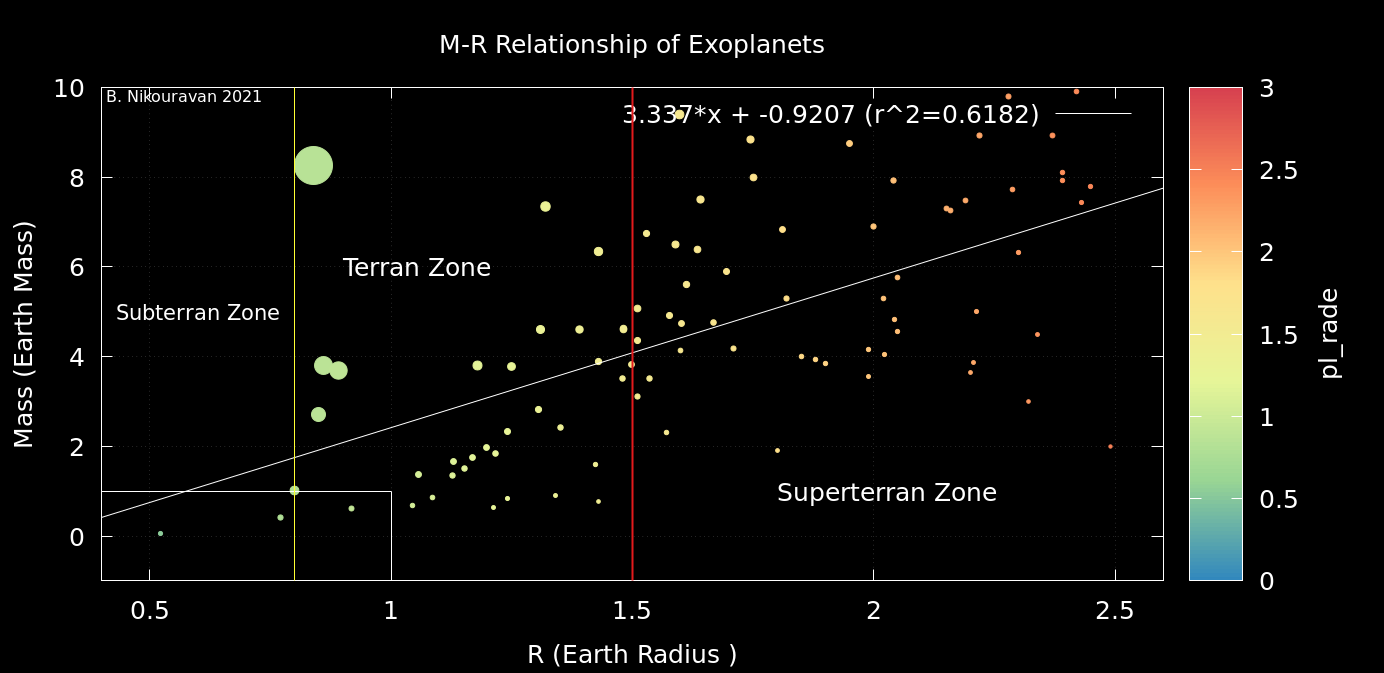Estimating Physical Properties of Confirmed Exoplanets: I. Calculation of essential planetary properties-Possible M-R cataloging of exoplanets
Exoplanets New Classification
DOI:
https://doi.org/10.14331/ijfps.2021.330146Keywords:
Planetary system, extrasolar planets, physical properties of exoplanets, Mass-Radius relationship, exoplanet classificationAbstract
The discovery of extrasolar planets outside our solar system and around other stars is now well underway. In the presented paper, calculations of some physical properties for confirmed exoplanets have been done. We have estimated physical properties such as the semi-major axis for potentially habitable exoplanets, the mass of planets by applying Kepler's third law around the mass of solar, Jupiter, and Earth-mass, stellar luminosity, habitability zone for the inner center and outer regions, radial velocity amplitude, planetary equilibrium temperature (PET) or effective radiation emission temperature and planet density. The mass-radius (MR) relationship of planets was investigated for potentially habitable exoplanets of three different groups of extrasolar planets: Subterran (Mars-size), Terran (Earth-size), and Superterran (Super-Earths or Mini-Neptunes); introduced in PHL, and found well coefficient values for each group. The minimum and maximum values for the mass and radius of exoplanets have been selected from 0.1< M < 10 M⊕ and 0.4 < R < 2.5 R⊕ . The same MR relationship has also estimated the same properties for a larger number of confirmed exoplanets with a mass and radius of 0.1< M <100 M⊕ and 0.4< R < 15 R⊕ , respectively, resulting their classification within 7 groups of mass and radius, with good coefficient values for each group. This is a new, possible cataloging that may need more effort for concluding a better understanding of the properties and varieties of the exoplanets.
Downloads
References
Akeson, R., Chen, X., Ciardi, D., Crane, M., Good, J., Harbut, M., . . . Leifer, S. J. P. o. t. A. S. o. t. P. (2013). The NASA exoplanet archive: data and tools for exoplanet research. 125(930), 989.
Alibert, Y. J. A., & Astrophysics. (2014). On the radius of habitable planets. 561, A41.
Baraffe, I., Chabrier, G., & Barman, T. J. R. o. P. i. P. (2009). The physical properties of extra-solar planets. 73(1), 016901.
Bashi, D., Helled, R., Zucker, S., Mordasini, C. J. A., & Astrophysics. (2017). Two empirical regimes of the planetary mass-radius relation. 604, A83.
Kasting, J. F., Whitmire, D. P., & Reynolds, R. T. J. I. (1993). Habitable zones around main sequence stars. 101(1), 108-128.
Malhotra, R. J. T. A. J. (2015). The mass distribution function of planets. 808(1), 71.
Müller, S., Ben-Yami, M., & Helled, R. J. a. p. a. (2020). Theoretical vs. observational uncertainties: composition of giant exoplanets.
NASA Exoplanet Archive. (2021). Retrieved from: https://exoplanetarchive.ipac.caltech.edu/
Perryman, M. A. J. R. o. P. i. P. (2000). Extra-solar planets. 63(8), 1209.
Planetary Habitability Laboratory. (2021). The Habitable Exoplanets Catalog. http://phl.upr.edu/
Raymond, S. N., Quinn, T., & Lunine, J. I. J. A. (2007). High-resolution simulations of the final assembly of Earth-like planets. 2. Water delivery and planetary habitability. 7(1), 66-84.
Seager, S., Kuchner, M., Hier-Majumder, C., & Militzer, B. J. T. A. J. (2007). Mass-radius relationships for solid exoplanets. 669(2), 1279.
Stull, R. B., & Ahrens, C. D. (2015). Meteorology for Scientists and Engineers, 3rd Edition: Brooks/Cole, Page 794.
Weiss, L. M., & Marcy, G. W. J. T. A. J. L. (2014). The mass-radius relation for 65 exoplanets smaller than 4 Earth radii. 783(1), L6.

Published
How to Cite
Issue
Section
License
Copyright (c) 2021 Fundamental Journals

This work is licensed under a Creative Commons Attribution-NonCommercial 4.0 International License.











